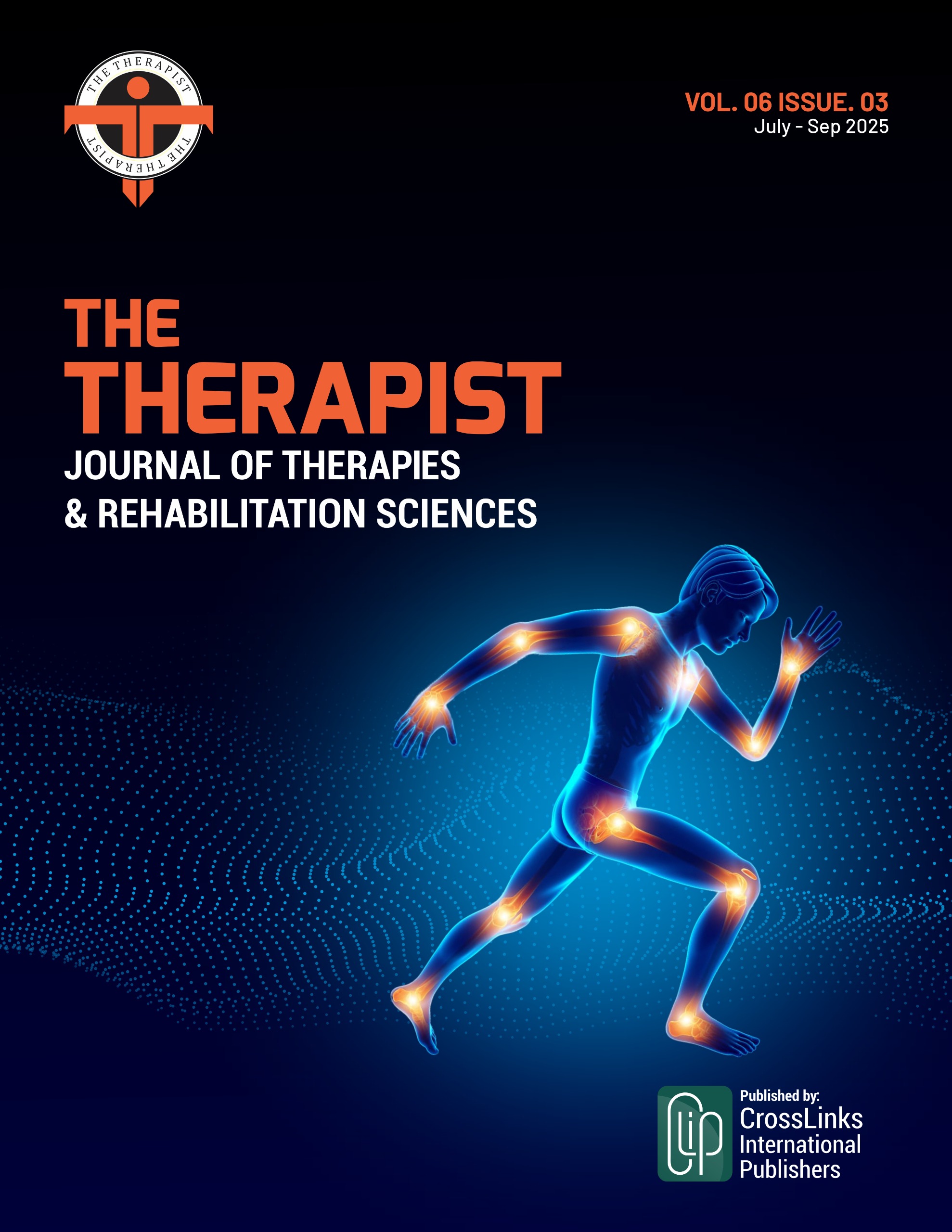Beyond Sleep Hygiene: A Multidimensional Clinical Profile for Precision CBT-I in Distressed University Students
Multidimensional Sleep Disturbance in University Students
DOI:
https://doi.org/10.54393/tt.v6i3.282Keywords:
Sleep Dysfunction, Cognitive-Behavioral Therapy for Insomnia, Nocturnal Hyperarousal, Digital Stimulation, Therapeutic AssessmentAbstract
Sleep disturbance is a core transdiagnostic factor in mental health, intricately linked to the onset and maintenance of depression. Objectives: To identify the underlying clinical dimensions of sleep disturbance in university students and explore their behavioral and cognitive predictors. Methods: This cross-sectional study of 151 students from the University of the Punjab was conducted using a comprehensive sleep questionnaire. Data were analyzed using exploratory factor analysis to identify latent constructs of sleep disturbance, with group differences examined via Mann-Whitney U and Kruskal-Wallis tests. Regression analyses identified key behavioral and cognitive predictors of adverse sleep outcomes. Results: Factor analysis revealed eight distinct clinical dimensions of sleep disturbance: Daytime Impairment, Clinical Sleep Disorders, Perceived Sleep Quality, Sleep Hygiene, Sleep Fragmentation, Pre-sleep Stimulation, Nocturnal Hyperarousal, and Autonomic Symptoms. Clinically significant group differences emerged: females reported greater daytime functional impairment (p=0.009), while males endorsed poorer perceived sleep quality (p=0.027). Lower family income was uniquely associated with increased sleep fragmentation (p=0.034). Critically, regression models identified pre-bed screen use as a significant predictor of reduced total sleep duration (p=0.007) and nocturnal cognitive hyperarousal (worry) as a predictor of prolonged sleep onset latency (p=0.036). Conclusions: Sleep disturbances in university students comprise multiple, co-occurring dimensions rather than a single deficit. Personalized strategies combining stimulus control and cognitive techniques can directly address the core drivers of sleep dysfunction in this population.
References
Hasan F, Tu YK, Yang CM, Gordon CJ, Wu D, Lee HC, et al. Comparative Efficacy of Digital Cognitive Behavioral Therapy for Insomnia: A Systematic Review and Network Meta-Analysis. Sleep Medicine Reviews. 2022 Feb; 61: 101567. doi: 10.1016/j.smrv.2021.101567.
Xie J, Li Y, Zhang Y, Vgontzas AN, Basta M, Chen B, et al. Sleep Duration and Metabolic Syndrome: An Updated Systematic Review and Meta-Analysis. Sleep Medicine Reviews. 2021 Oct; 59: 101451. doi: 10.1016/j.smrv.2021.101451.
Freeman D, Sheaves B, Waite F, Harvey AG, Harrison PJ. Sleep Disturbance and Psychiatric Disorders. The Lancet Psychiatry. 2020 Jul; 7(7):628-37. doi: 10.1016/S2215-0366(20)30136-X.
Scott H, Biello SM, Woods HC. Social Media Use and Adolescent Sleep Patterns: Cross-Sectional Findings from the UK Millennium Cohort Study. BMJ Open. 2019 Sep; 9(9): e031161. doi: 10.1136/bmjopen-2019-031161.
Duncan MJ, Oftedal S, Rebar AL, Murawski B, Short CE, Rayward AT, et al. Patterns of Physical Activity, Sitting Time, and Sleep in Australian Adults: A Latent Class Analysis. Sleep Health. 2020 Dec; 6(6): 828-34. doi: 10.1016/j.sleh.2020.04.006.
Matko K, Berghöfer A, Jeitler M, Sedlmeier P, Bringmann HC. Who Benefits Most? Interactions between Personality Traits and Outcomes of Four Incremental Meditation and Yoga Treatments. Journal of Clinical Medicine 2022 Aug; 11(15):4553. doi: 10.3390/jcm11154553.
Xu N, Wu Q, Ma L, Yu B. Can Afternoon Napping Protect Against the Negative Effects of Short or Long Sleep Duration on Cognitive Function? A Prospective Study. Sleep Medicine. 2023 Feb; 102: 1-8. doi: 10.1016/j.sleep.2022.12.012.
Twenge JM, Hisler GC, Krizan Z. Associations Between Screen Time and Sleep Duration Are Primarily Driven by Portable Electronic Devices: Evidence from a Population-Based Study of US Children Ages 0-17. Sleep Medicine. 2019 Apr; 56: 211-8. doi: 10.1016/j.sleep.2018.11.009.
Miola A, Alvarez-Villalobos NA, Ruiz-Hernandez FG, De Filippis E, Veldic M, Prieto ML, et al. Insulin Resistance in Bipolar Disorder: A Systematic Review of Illness Course and Clinical Correlates. Journal of Affective Disorders. 2023 Aug; 334: 1-1. doi: 10.1016/j.jad.2023.04.068.
Leong CW, Leow JW, Grunstein RR, Naismith SL, Teh JZ, D'Rozario AL, et al. A Systematic Scoping Review of the Effects of Central Nervous System Active Drugs on Sleep Spindles and Sleep-Dependent Memory Consolidation. Sleep Medicine Reviews. 2022 Apr; 62: 101605. doi: 10.1016/j.smrv.2022.101605.
Almojali AI, Almalki SA, Alothman AS, Masuadi EM, Alaqeel MK. The Prevalence and Association of Stress with Sleep Quality Among Medical Students. Journal of Epidemiology and Global Health. 2017 Jan; 7(3): 169-74. doi: 10.1016/j.jegh.2017.04.005.
Sürücü L, Yıkılmaz İ, Maşlakçı A. Exploratory Factor Analysis (EFA) in Quantitative Researches and Practical Considerations. Gümüşhane Üniversitesi Sağlık Bilimleri Dergisi. 2022; 13(2): 947-65. doi: 10.37989/gumussagbil.1183271.
Carmassi C, Cruz-Sanabria F, Gravina D, Violi M, Bonelli C, Dell'Oste V, et al. Exploratory Study on the Associations Between Lifetime Post-Traumatic Stress Spectrum, Sleep, and Circadian Rhythm Parameters in Patients With Bipolar Disorder. International Journal of Environmental Research and Public Health. 2023 Feb; 20(4): 3566. doi: 10.3390/ijerph20043566.
Abbott SM, Choi J, Wilson IV J, Zee PC. Melanopsin-Dependent Phototransduction Is Impaired in Delayed Sleep-Wake Phase Disorder and Sighted Non-24-Hour Sleep-Wake Rhythm Disorder. Sleep. 2021 Feb; 44(2): zsaa184. doi: 10.1093/sleep/zsaa184.
de Zambotti M, Trinder J, Silvani A, Colrain IM, Baker FC. Dynamic Coupling Between the Central and Autonomic Nervous Systems During Sleep: A Review. Neuroscience & Biobehavioral Reviews. 2018 Jul; 90: 84-103. doi: 10.1016/j.neubiorev.2018.03.027.
Baglioni C, Altena E, Bjorvatn B, Blom K, Bothelius K, Devoto A, et al. The European Academy for Cognitive Behavioural Therapy for Insomnia: An Initiative of the European Insomnia Network to Promote Implementation and Dissemination of Treatment. Journal of Sleep Research. 2020 Apr; 29(2): e12967. doi: 10.1111/jsr.12967.
Park KM, Kim KT, Lee DA, Cho YW. Redefining the Role of the Cerebellum in Restless Legs Syndrome. Sleep Medicine. 2023 Dec; 112: 256-61. doi: 10.1016/j.sleep.2023.10.030.
Bai W, Zhang J, Smith RD, Cheung T, Su Z, Ng CH, et al. Inter-Relationship Between Cognitive Performance and Depressive Symptoms and Their Association with Quality of Life in Older Adults: A Network Analysis Based on the 2017-2018 Wave of Chinese Longitudinal Healthy Longevity Survey (CLHLS). Journal of Affective Disorders. 2023 Jan; 320: 621-7. doi: 10.1016/j.jad.2022.09.159.
Hajjar ST. Statistical Analysis: Internal-Consistency Reliability and Construct Validity. International Journal of Quantitative and Qualitative Research Methods. 2018 Feb; 6(1): 27-38.
Maurer LF. The Mechanisms of Sleep Restriction Therapy for Insomnia Disorder (Doctoral Dissertation, University of Oxford). 2020. doi: 10.1186/ISRCTN10974094.
Downloads
Published
How to Cite
Issue
Section
License
Copyright (c) 2025 THE THERAPIST (Journal of Therapies & Rehabilitation Sciences)

This work is licensed under a Creative Commons Attribution 4.0 International License.
This is an open-access journal and all the published articles / items are distributed under the terms of the Creative Commons Attribution License, which permits unrestricted use, distribution, and reproduction in any medium, provided the original author and source are credited. For comments editor@thetherapist.com.pk










